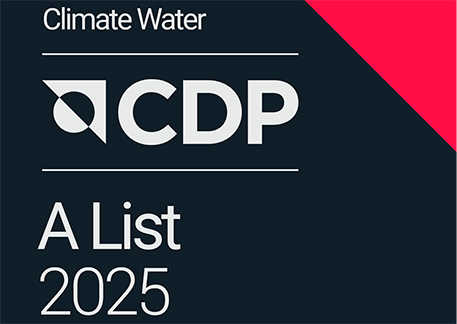Sacyr forma parte de la 'Lista doble A' de CDP, en la que se encuentran las mejores empresas del mundo por su liderazgo en materia de cambio climático y de protección del recurso hídrico. CDP es una organización sin ánimo de lucro que gestiona el mayor sistema de divulgación ambiental del mundo.
Formar parte de la ‘Lista doble A’ demuestra el compromiso de Sacyr frente a los retos ambientales más urgentes.
En clima, Sacyr ha alcanzado la calificación “A” por cuarto año consecutivo, gracias a su estrategia de descarbonización y de gestión de los riesgos climáticos. En agua, se mantiene por tercer año en la banda de liderazgo, con una trayectoria ascendente y obteniendo también una “A”, lo que refleja su trabajo en la protección del recurso hídrico.
CDP analiza y puntúa a más de 24.800 empresas, la base de datos medioambiental más grande del mundo, alineada con el Task Force on Climate-Related Financial Disclosures (TCFD). Los datos de este cuestionario impulsan la transformación de las personas y el planeta: permiten armonizar el clima y la naturaleza con las necesidades económicas. La información obtenida a través de la divulgación se convierte en un recurso clave para políticas públicas, gobiernos, inversiones, compras y finanzas.
La calificación de CDP se basa en la divulgación voluntaria y detallada de datos ambientales, que permiten evaluar la gestión de riesgos y oportunidades relacionados con el cambio climático y el agua. Ser parte de la Lista A implica estar entre el reducido grupo de compañías que lideran la transición hacia una economía más sostenible y resiliente.
Patricia Martínez Íñigo, directora general de Sostenibilidad, Medio Ambiente e Innovación de Sacyr, destaca: “Formar parte por cuarto año consecutivo de la banda de liderazgo del cuestionario más exigente en términos de divulgación ambiental demuestra que nuestra estrategia es sólida y consistente. Reducir emisiones y gestionar responsablemente el recurso hídrico nos permite generar valor duradero para nuestros clientes, inversores y comunidades”.
Avanzando hacía la descarbonización
Durante este año, Sacyr ha reafirmado su liderazgo climático revalidando sus objetivos climáticos basados en la ciencia. La Iniciativa de Objetivos Basados en la Ciencia (SBTi por sus siglas en inglés) ha reevaluado exhaustivamente los objetivos de Sacyr y ha confirmado que se mantienen en línea con una trayectoria de 1,5 °C, el nivel de ambición más alto posible según sus criterios.
En concreto, Sacyr tiene el compromiso de reducir las emisiones absolutas de gases de efecto invernadero (GEI) de alcance 1 y 2 el 42% para 2030, tomando como año base 2020, y de reducir las emisiones absolutas de GEI de alcance 3 -que abarcan bienes y servicios adquiridos, actividades relacionadas con combustibles y energía, y residuos generados en las operaciones- el 25% dentro del mismo plazo.
Sacyr cuenta con un Plan de Descarbonización conformado por más de 300 proyectos que se desarrollan en las diferentes líneas de negocio y en todas las ubicaciones donde Sacyr tiene presencia.
Water Positive
Sacyr fue la primera empresa del Ibex 35 en verificar su huella de agua conforme a la norma ISO 14046. En 2025, ha certificado con AENOR por cuarto año consecutivo esta verificación, consolidando su liderazgo en la protección del recurso hídrico dentro del sector de infraestructuras.
Sacyr tiene como objetivo reducir antes de 2027 al menos el 5% del consumo de agua propio en todas sus actividades, tanto en zonas de estrés hídrico alto como bajo. Para ello, evalúa su huella de agua para conocer, identificar y valorar los impactos reales y potenciales relacionados con el agua dulce y marina.
Las actividades de Sacyr en depuración de aguas residuales mejoran significativamente los parámetros de calidad de este elemento.
Asimismo, las plantas de desalinización gestionadas por Sacyr Agua, aportan agua dulce en regiones con elevado estrés hídrico, generando un impacto positivo en el entorno.
CDP
Carbon Disclosure Project (CDP) es una organización mundial sin ánimo de lucro que gestiona el sistema independiente de divulgación medioambiental para que empresas, mercados de capitales, ciudades, estados y regiones gestionen su impacto medioambiental.
